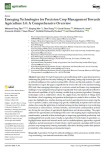Taha M.F., Mao H., Zhang Z., Elmasry G., Awad M.A., Abdalla A., Mousa S., Elwakeel A.E., Elsherbiny O. (2025). Emerging technologies for precision crop management towards agriculture 5.0: a comprehensive overview. Agriculture, 02/03/2025, vol. 15, n. 6, p. 582.
https://doi.org/10.3390/agriculture15060582
https://doi.org/10.3390/agriculture15060582
| Titre : | Emerging technologies for precision crop management towards agriculture 5.0: a comprehensive overview (2025) |
| Auteurs : | M.F. Taha ; H. Mao ; Z. Zhang ; G. Elmasry ; M.A. Awad ; A. Abdalla ; S. Mousa ; A.E. Elwakeel ; O. Elsherbiny |
| Type de document : | Article |
| Dans : | Agriculture (vol. 15, n. 6, March 2025) |
| Article en page(s) : | p. 582 |
| Langues : | Anglais |
| Langues du résumé : | Anglais |
| Catégories : |
Catégories principales 06 - AGRICULTURE. FORÊTS. PÊCHES ; 6.4 - Production Agricole. Système de ProductionThésaurus IAMM SYSTEME DE PRODUCTION ; NOUVELLE TECHNOLOGIE ; NOUVELLE TECHNOLOGIE DE L'INFORMATION ET DE LA COMMUNICATION ; AGRICULTURE DE PRECISION ; INTELLIGENCE ARTIFICIELLE ; RESEAU DE NEURONES |
| Résumé : | Agriculture 5.0 (Ag5.0) represents a groundbreaking shift in agricultural practices, addressing the global food security challenge by integrating cutting-edge technologies such as artificial intelligence (AI), machine learning (ML), robotics, and big data analytics. To adopt the transition to Ag5.0, this paper comprehensively reviews the role of AI, machine learning (ML) and other emerging technologies to overcome current and future crop management challenges. Crop management has progressed significantly from early agricultural methods to the advanced capabilities of Ag5.0, marking a notable leap in precision agriculture. Emerging technologies such as collaborative robots, 6G, digital twins, the Internet of Things (IoT), blockchain, cloud computing, and quantum technologies are central to this evolution. The paper also highlights how machine learning and modern agricultural tools are improving the way we perceive, analyze, and manage crop growth. Additionally, it explores real-world case studies showcasing the application of machine learning and deep learning in crop monitoring. Innovations in smart sensors, AI-based robotics, and advanced communication systems are driving the next phase of agricultural digitalization and decision-making. The paper addresses the opportunities and challenges that come with adopting Ag5.0, emphasizing the transformative potential of these technologies in improving agricultural productivity and tackling global food security issues. Finally, as Agriculture 5.0 is the future of agriculture, we highlight future trends and research needs such as multidisciplinary approaches, regional adaptation, and advancements in AI and robotics. Ag5.0 represents a paradigm shift towards precision crop management, fostering sustainable, data-driven farming systems that optimize productivity while minimizing environmental impact. |
| Cote : | En ligne |
| URL / DOI : | https://doi.org/10.3390/agriculture15060582 |







